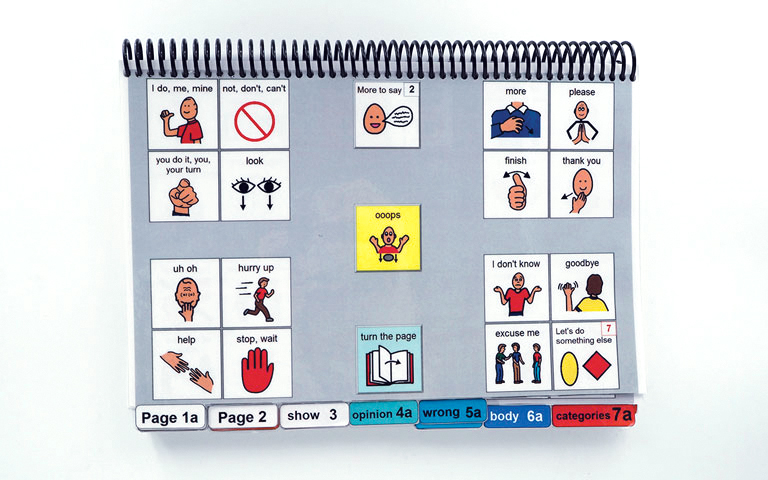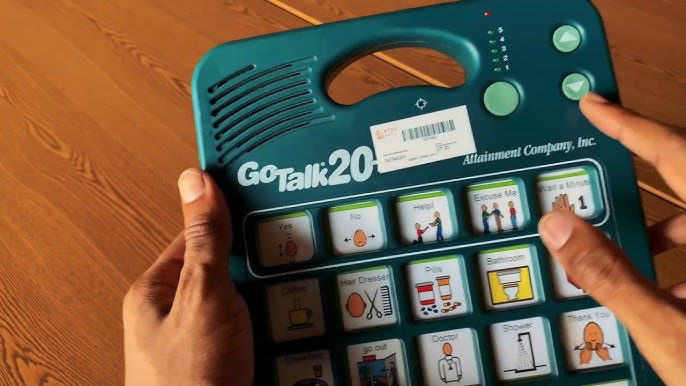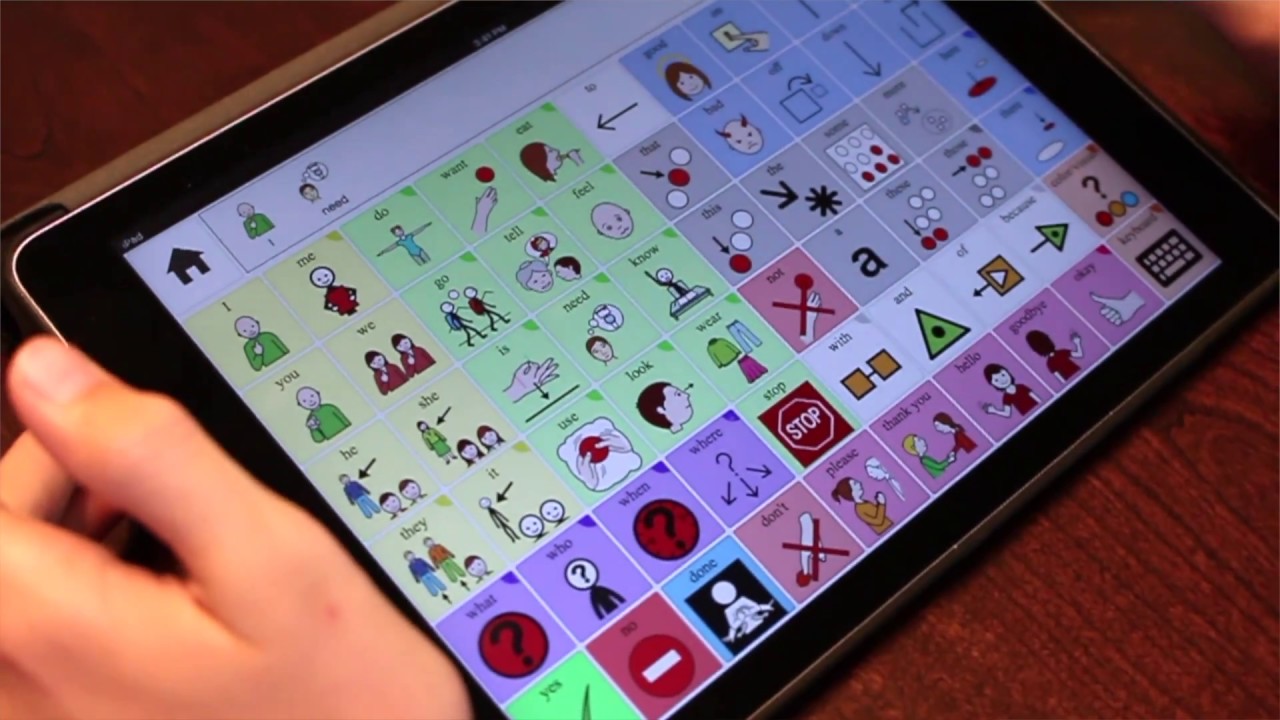Learning About AAC
There's always more to learn!
Below are some additional topics and learning sites that may be useful once you’ve started down your AAC journey. There’s always more to learn about AAC, and that can feel intimidating, but if you’re patient with yourself and others, you’ll learn that everyone can make a difference for AAC users, even if they don’t have it all figured out yet!
Topics
- Types of AAC
- Symbols and Text
- Modeling
- Finding the Right Fit
- Core Word Strategies
- UATT Training Videos
- Additional Resources
- School/Community Resources
Types of AAC
AAC is often separated into three different categories: low (or light)-tech, mid-tech, and high-tech. All three can provide significant value for different individuals. Here’s a brief explainer of the three: Low, Mid and High-Tech AAC options
Here’s a list of some AAC options across different categories:
High Tech AAC
- Tablet-Based AAC Systems: Specialized software running on tablets that can be customized for individual needs.
- Communication Apps: Apps installed on tablets or smartphones with text-to-speech functionality, such as Proloquo2Go or TouchChat.
- Eye-Tracking AAC Systems: Devices that track eye movement to select symbols or words on a screen.
- Alternative Access Apps: For those physically unable to use the touchscreen, SGDs offer flexible access options including: Eye-gaze Head tracking Joystick and alternative mouse control Single and multiple switch control Thus, even children with severe physical disabilities can operate a life-changing AAC device.
Pros:
|
Cons:
|
It's important to remember that the choice of AAC system depends on an individual, everyone has different needs, preferences and abilities. Professional consultants like speech-language pathologists can provide an assessment, which will help in selecting the most appropriate AAC solution for each person. Additionally, the field of AAC continues to evolve with advancements in technology, so new solutions may become available over time.
Symbols and Text
 Many forms of AAC use text or images (often called symbols) to show options for the AAC user to select. For some users, showing pictures may be easier for them to find and select, but words can be shown at the same time to gradually develop literacy. There are a number of different AAC symbol libraries available, some are free and some
are proprietary.
Many forms of AAC use text or images (often called symbols) to show options for the AAC user to select. For some users, showing pictures may be easier for them to find and select, but words can be shown at the same time to gradually develop literacy. There are a number of different AAC symbol libraries available, some are free and some
are proprietary.
Much research has gone into what symbols work best for AAC users. Jane Farrall summarized some of this research here. She observes that there is no evidence that more concrete symbols work better than abstract ones, and that often different types of symbols (nouns, verbs, adjectives, etc.) are combined and taught at the same time. For many AAC users the meaning of the symbol is not as important as its consistent location and representation, which is what allows them to gain proficiency more easily.
Modeling
 There are many terms in the industry used to represent a similar idea, sometimes called “modeling”. The idea is that, just like with any other language learner, AAC users will get more comfortable and understand more about using their AAC system when they see others use it. As others provide examples of how AAC can be used to make requests, respond to questions, start conversations, express needs, etc. the AAC user can pick on strategies that will work for them individually. Ideally they would see others use AAC in multiple different settings and with multiple communication partners.
There are many terms in the industry used to represent a similar idea, sometimes called “modeling”. The idea is that, just like with any other language learner, AAC users will get more comfortable and understand more about using their AAC system when they see others use it. As others provide examples of how AAC can be used to make requests, respond to questions, start conversations, express needs, etc. the AAC user can pick on strategies that will work for them individually. Ideally they would see others use AAC in multiple different settings and with multiple communication partners.
AssistiveWare has provided some useful pointers for developing communication partner skills for AAC learners, including some additional jumping-off point links at the bottom of the article.
One researched approach to modeling is called SMoRRES - Slow Rate, MOdel, Respect and Reflect, Repeat, Expand, Stop. During studies, parents significantly increased percentage of utterances modeled on their children’s SGDs between pretest and post-test measures. Three of four child participants demonstrated increases in unique words used following parent instruction.
When modeling and teaching AAC, there can be a tendency to treat AAC use as an assignment or quiz. If you find yourself prompting an AAC user and expecting a specific correct answer, you may want to rethink your support strategy, as too much prompting can negatively affect the adoption of AAC. For more information, see Rachel Langley’s Revisiting the Prompt Hierarchy
Finding the Right Fit
 AAC Feature Matching Module from University of Wisconsin - Feature Matching is a collaborative process which involves using criterion-based assessment strategies to gather relevant information about a client’s communication and sensorimotor abilities and applying AAC expertise to match the appropriate array of AAC options that offer features relevant for meeting the person’s needs and skills.
AAC Feature Matching Module from University of Wisconsin - Feature Matching is a collaborative process which involves using criterion-based assessment strategies to gather relevant information about a client’s communication and sensorimotor abilities and applying AAC expertise to match the appropriate array of AAC options that offer features relevant for meeting the person’s needs and skills.
Core Word Strategies
 Project Core - Professional Development Modules
are a collection of learning resources that can help you learn more about core words and why they are important for all communicators.
Project Core - Professional Development Modules
are a collection of learning resources that can help you learn more about core words and why they are important for all communicators.
Communication Workshop
is a place to look at some of the core language that we use every day, core words that can be modeled in a variety of ways all day!
You can use low or high tech AAC with any ideas shown here. An example can be the word ‘go’. Along with getting ready to ‘go’ in the car or making something ‘go’ there are many ideas to explore that can show how language can be used with this word.
4 things every AAC system needs - Select a balanced or robust AAC system, with core words and quick access to fringe vocabulary, and the alphabet. A balanced AAC tool will let you communicate for a wide variety of reasons.
UATT Training Videos
The following are videos found on the Utah Assistive Technology Teams YouTube channel can be a place to start when learning about Augmentative and Alternative Communication (AAC). They are between 8-20 minutes long and show about (1) language development, (2) what modeling language can look like as well as some of the (3) differences between communication and requesting. The videos then move into (4) teaching language and communication skills with more about (5) communication partners. Starting with the first three is a place to begin. Pause there and think about 1 or 2 things you can start to do in your home or school setting. These videos build your knowledge of AAC and language with these steps.
Additional Resources
The Northwest Augmentative Communication Society (NWACS) has gathered a collection of resources for training communication partners. These resources are for educational purposes, and can be a good starting point for finding additional resources.
United States Society for Augmentative and Alternative Communication (USSAAC) is a national organization with a focus on supporting the needs and rights of people who use AAC. They provide meaningful resources and ideas for AAC implementations and ongoing use.
What AAC terminology should I use? - insights from a community survey. Words can shape perceptions. In early 2022, AssistiveWare ran an online survey, asking people with a variety of relationships to AAC what they thought about 119 different words and phrases. The first research of its kind, the survey resonated deeply with the community—in total, 556 people participated. Now, considering the preferences of people who use AAC, their relatives, and AAC professionals, we can share our overall recommendations. This poster shows the results of the survey.
School/Community Resources
Having a communication is that is supportive, interactive, and responsive is necessary for AAC users to learn how to communicate effectively. It can als be important for the team around an AAC user to feel like they have the support that they need to be successful and most effective.
There are many online groups and communities where families can network if they would like to connect with or learn from others in the field of AAC.
The Utah Parent Center also has a collection of resources on the adoption and use of Assistive Technology.
NWACS - AAC Myths from the Northwest Augmentative Communication Society
AAC coaching services at home and in schools
Having communication partners at school who understand the individual and can effectively support them, may take time. People need to learn how the communicator prefers to be interacted with, and how they can be an effective communication partner.
 Utah Center for AAC Excellence
Utah Center for AAC Excellence


 Intro to AAC and Language Development
Intro to AAC and Language Development Modeling Language using AAC
Modeling Language using AAC Communicating versus Responding
Communicating versus Responding Teaching Language and Communication Skills
Teaching Language and Communication Skills Supportive Communication Partners
Supportive Communication Partners Aided Language Stimulation Explained by Chris Bugaj (2:31 video)
Aided Language Stimulation Explained by Chris Bugaj (2:31 video) How to Get Started Modeling Language on AAC (2:36 video)
How to Get Started Modeling Language on AAC (2:36 video)